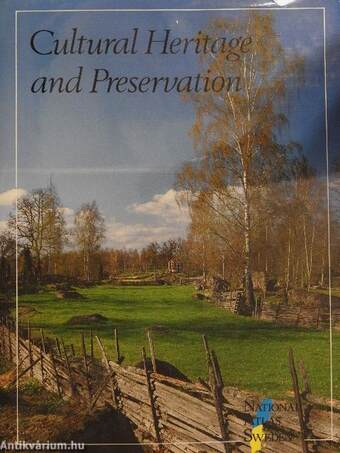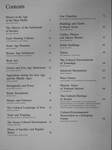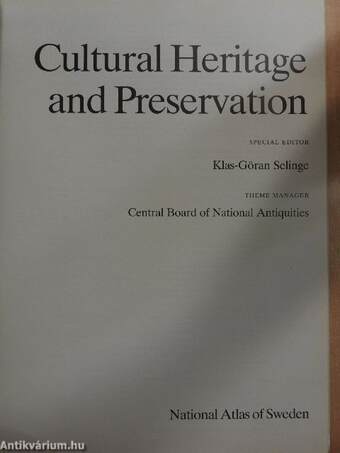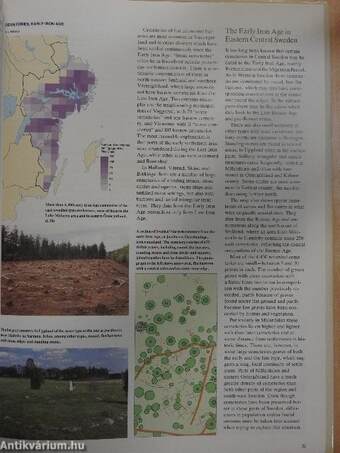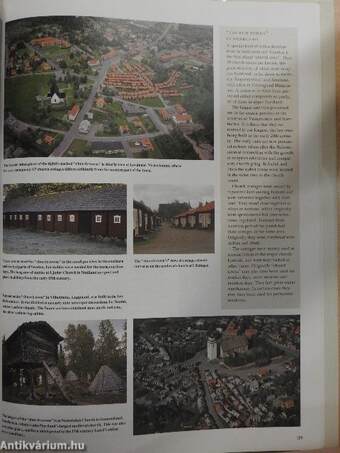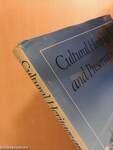1.067.053
kiadvánnyal nyújtjuk Magyarország legnagyobb antikvár könyv-kínálatát

VISSZA
A TETEJÉRE
JAVASLATOKÉszre-
vételek
Cultural Heritage and Preservation
| Kiadó: | SNA Publishing |
|---|---|
| Kiadás helye: | |
| Kiadás éve: | |
| Kötés típusa: | Fűzött keménykötés |
| Oldalszám: | 184 oldal |
| Sorozatcím: | National Atlas of Sweden |
| Kötetszám: | |
| Nyelv: | Angol |
| Méret: | 34 cm x 25 cm |
| ISBN: | 91-87760-26-6 |
| Megjegyzés: | Színes fotókkal, illusztrációkkal. További kapcsolódó személyek a könyvben. |
naponta értesítjük a beérkező friss
kiadványokról
naponta értesítjük a beérkező friss
kiadványokról
Fülszöveg
Cultural Heritage anc Preservation
?r
l < M
Special Editor:
Klas-Goran Selinge is a Reader in archeology and an expert at the Central Board of National Antiquities, Stockholm. The aim of the National Atlas of Sweden is to give an up-to-date picture of the country and its people at the end of the 20th century. But no picture of this kind can ever be complete or easily comprehensible without a historical perspective. How has Sweden become what it is today? What has been preserved from earlier times?
When we speak of our cultural heritage -often somewhat solemnly yet quite factually - we include all the relics of mankind from bygone times and cultures, but also the changes man has brought about in the landscape. A broad cultural concept of this kind often distinguishes between cultural monuments, that is, physical entities such as prehistoric remains, and the cultural environment, which covers the historical dimension as a whole in the cultural landscape.
Not everything that... Tovább
Fülszöveg
Cultural Heritage anc Preservation
?r
l < M
Special Editor:
Klas-Goran Selinge is a Reader in archeology and an expert at the Central Board of National Antiquities, Stockholm. The aim of the National Atlas of Sweden is to give an up-to-date picture of the country and its people at the end of the 20th century. But no picture of this kind can ever be complete or easily comprehensible without a historical perspective. How has Sweden become what it is today? What has been preserved from earlier times?
When we speak of our cultural heritage -often somewhat solemnly yet quite factually - we include all the relics of mankind from bygone times and cultures, but also the changes man has brought about in the landscape. A broad cultural concept of this kind often distinguishes between cultural monuments, that is, physical entities such as prehistoric remains, and the cultural environment, which covers the historical dimension as a whole in the cultural landscape.
Not everything that man has created has survived; indeed, much of it was never even intended to be preserved. Cultural monuments have always been subject to wear and tear, restoration, re-use and destruction. Our knowledge of what remains today varies in scope and quality, which affects the current picture of our cultural heritage.
Yet our cultural monuments and cultural environments can throw light on most aspects of previous societies: colonisation and settlement, economy and work, technology and communications, social groups and values, ideology and religion. We have chosen to throw light on as much as possible of this complex picture of human activities, which means that many aspects have only been touched on. Presenting the cultural heritage in map form, however, may provide new insights into old facts which are well known to many people.
Let these samples whet your appetite for further studies: in the landscape, in museums and in books. The bridge for every generation between the past and the future.
Cover illustration: Spring in Smaland. Photo: Jan-Peter Lahall/GreatShots Vissza
Témakörök
- Idegennyelv > Idegennyelvű könyvek > Angol > Művészetek > Építészet
- Idegennyelv > Idegennyelvű könyvek > Angol > Művelődéstörténet
- Idegennyelv > Idegennyelvű könyvek > Angol > Helytörténet
- Idegennyelv > Idegennyelvű könyvek > Angol > Történelem > Európa története > Egyéb
- Művelődéstörténet > Kultúra > Története
- Helytörténet > Honismeret > Országos
- Művészetek > Építészet > Kontinensek szerint > Európa > Egyéb
- Művészetek > Építészet > Idegen nyelv > Angol
- Művészetek > Építészet > Műemlékek > Műemlékvédelem
- Történelem > Idegennyelvű > Angol
- Idegennyelv > Idegennyelvű könyvek > Angol > Régészet > Kontinensek szerint > Európa
- Történelem > Kontinensek szerint > Európa, európai országok története > Észak-Európa
- Régészet > Kontinensek szerint > Európa > Egyéb
- Történelem > Régészet > Kontinensek szerint > Európa > Egyéb



